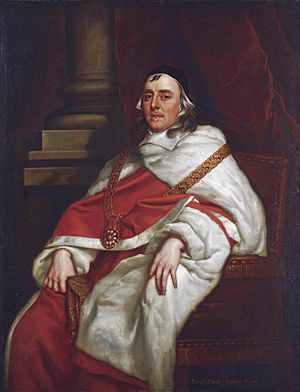John Glynne (judge) facts for kids
Sir John Glynne (born 1602 – died 15 November 1666) was an important Welsh lawyer. He lived during a time of big changes in England, known as the Commonwealth and Restoration periods. He became a very high-ranking judge, the Lord Chief Justice of the Upper Bench, under Oliver Cromwell. He was also a member of the House of Commons, which is like a part of today's Parliament, at different times between 1640 and 1660.
Contents
Early Life and Education
John Glynne was born in a place called Glynllifon in Carnarvonshire, Wales. He was the second son of Sir William Glynne, who came from a very old family.
John went to school at Westminster School and then studied at Hart Hall, Oxford. He started studying law at Lincoln's Inn in London in 1620 and became a lawyer, called a Barrister, in 1628.
His Career in Law and Politics
Starting in Parliament
In April 1640, John Glynne was chosen to be a Member of Parliament (MP) for Westminster. This was for a short time, in what was called the Short Parliament. He was chosen again for Westminster in November 1640 for the Long Parliament, which lasted much longer.
Rising as a Judge
John Glynne had a very successful career during the Commonwealth period. He played a key role in a big legal case against the Earl of Strafford. He became a senior lawyer called a serjeant-at-law and a judge. Eventually, he became the Lord Chief Justice of the Upper Bench, which was one of the most important courts. He was also part of a group called the Committee of Both Kingdoms, which helped run the country.
However, John Glynne was a Presbyterian, which was a type of Protestant religion. His religious views didn't always agree with the army at the time. Because of this, he was removed from Parliament in 1647 and put in the Tower for almost a year.
After his release, he worked as a lawyer for the University of Cambridge from 1647 to 1660. He returned to Parliament as an MP for Caernarvonshire from 1654 to 1655. In 1656, he was elected MP for both Carnarvonshire and Flintshire. He chose to represent Flintshire. He was also given a seat in Cromwell's Other House, which was like another part of Parliament.
The George Fox Case
In 1656, John Glynne was the judge in a legal case involving George Fox, who started the Quaker movement. During the trial, Glynne told Fox to take off his hat, which Fox refused to do. Because Fox wouldn't obey, Glynne ordered him to pay a fine and sent him to prison.
Supporting the King's Return
As the Protectorate period came to an end, John Glynne decided to support the return of the King to power, known as the Restoration. He gave up his legal jobs. He was elected MP for Caernarvonshire again in the Convention Parliament in 1660. On 16 November 1660, he was made a knight, and soon after, he became the Prime Serjeant, another very important legal role.
Later Life and Family
John Glynne passed away at his home in London on 15 November 1666. He was buried in a special vault at St Margaret's Church in Westminster. He left his land in Hawarden to his son, Sir William Glynne, 1st Baronet. His other lands in Surrey went to his son John from his second marriage.
His Marriages and Children
John Glynne was married twice.
His first wife was Frances Squib. They had two sons and five daughters:
- Sir William Glynne, 1st Baronet
- Thomas
- Frances (who died as a baby)
- Jane, who married Sir Robert Williams
- Margaret (who died as a baby)
- Anne, who married Sir John Evelyn
- Frances, who married William Campion
His second wife was Anne Manning. They had a son and a daughter:
- John Glynne, who later owned land in Surrey.
- Mary, who married Sir Stephen Anderson.


